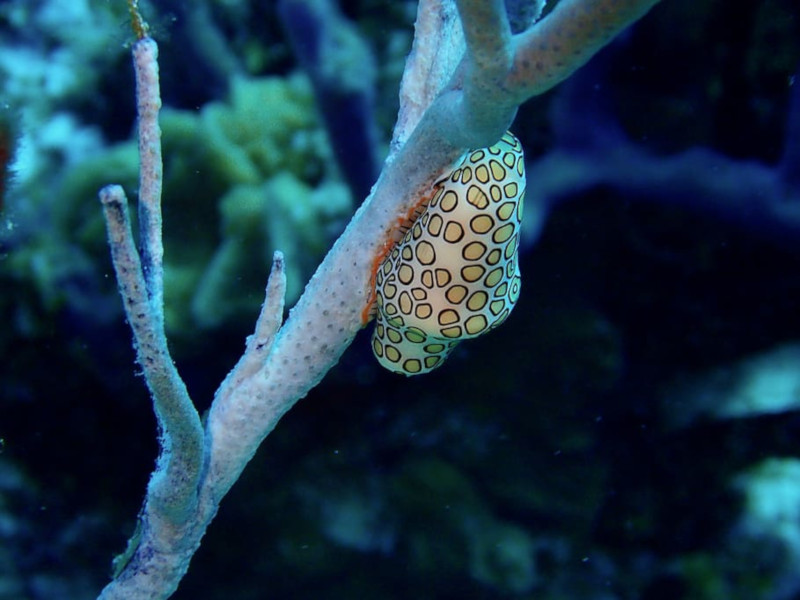
Flamingo Tongue Snail Facts
- The descriptive term of Flamingo Tongue Snail serves as the accepted common name for a remarkable variety of sea snail. This marvel of Nature also goes by another name, however. Among researchers, it’s known by the name Cyphoma gibbosum.
- Regardless of which name one uses, it remains a most fascinating creature. It also represents one of only eleven recognized species within its genus. Yet, even among its brethren this fabulous marine gastropod mollusk stands out from the crowd.
- That’s partly due to the fact that it’s one of the most colorful of them all. This wondrous animal also distinguishes itself in yet another manner. That’s because it remains the most numerous of its various relatives present within its native range.
- Sadly, though, this awesome creature once existed in much greater numbers. But, human tourism vastly reduced its population base throughout most of its natural territory. Divers and snorkelers often take the seemingly empty shells.
- For the moment, though, the Flamingo Tongue Snail does not appear on the IUCN Red List. Many experts nonetheless consider it to be at risk. While it still faces the dangers posed by tourists, its major threats now consist of habitat loss and climate change.
Related Articles




Flamingo Tongue Snail Physical Description
Perhaps most notably, describing the appearance of the Flamingo Tongue Snail is quite complicated. That’s due to the fact that its physical appearance varies significantly between when it is still alive, and immediately after its passing. That’s due to a unique characteristic.
Firstly, it itself remains a physically small specimen. In fact, the maximum measured body length only equals 1.7 in (4.3 cm). But an average length for the body is much smaller. The shape of the remarkable shell itself also typically develops as elongated in structure.
Secondly, while still living, the species generally displays a brilliant orange and yellow. It also often displays random black markings. Furthermore, these colors actually come from live tissue covering the shell itself. In this respect, the Flamingo Tongue Snail truly stands apart.
Thirdly, this covering can be withdrawn at will, but that rarely occurs while the creature lives. When the incredible creature dies, the colors fade. Finally, the smooth underside of the astonishing shell most commonly displays combinations of shades of pink and white.
- Kingdom: Animalia
- Phylum: Mollusca
- Class: Gastropoda
- Order: Neotaenioglossa
- Family: Ovulidae
- Genus: Cyphoma
- Species: C. gibbosum
Flamingo Tongue Distribution, Habitat, and Ecology
The Flamingo Tongue Snail inhabits a moderately broad range of the marine waters of the world. The exact area in which it appears likely comes as no great surprise, however. More precisely, it primarily lives in the warmer waters of the western Atlantic Ocean.
This amazing gastropod appears in a region that begins off the northern coast of the country of Brazil, in South America. From there, this marvelous denizen of the ocean appears as far north as the coast of the state of North Carolina, in the United States, in North America.
The range of the awesome gastropod also extends westward as well. Though populations remain smaller, it appears in the waters around Bermuda and the Lesser Antilles. Scattered specimens also appear in the Gulf of Mexico and the Caribbean Sea.
Throughout the entirety of its range, the gorgeous mollusk remains consistent in its choice of habitat. For one thing, the tiny beauty only lives in very shallow areas. In point of fact, the maximum depth at which any specimen has ever been spotted only measured 95 ft (29 m).
The diet of the aptly-named Flamingo Tongue Snail remains consistent with related species. The animal lives almost solely among coral reefs and feeds exclusively upon the flesh of soft coral. The species also evolved an almost symbiotic relationship with this life form.
The perfectly evolved creature of the sea feeds by scraping the fresh polyps off of the coral, finding hem easy prey. As most things in nature, this process is virtually perfect. The process does not harm the original coral, which subsequently regrows more polyps.
Species Sharing Its Range



Check out our other articles on Starfish, Pink Sea Through Fantasia, Namib Desert, Lions Mane Jellyfish, Pesquet’s Parrot, Venus Flytrap Anemone, Pfeffers Flamboyant Cuttlefish, Black Caiman










THANKS FOR THE HELP.